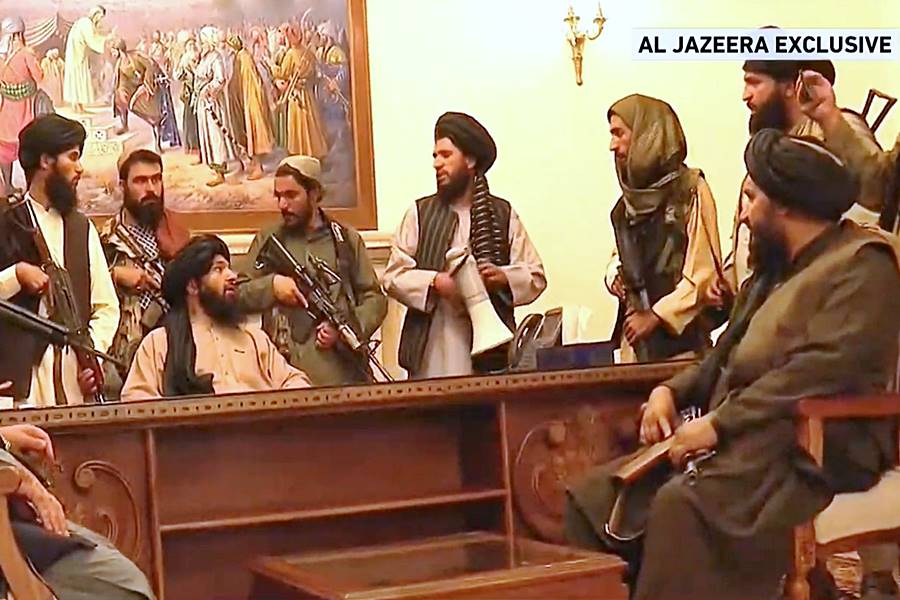Mon 15 August 2022:
On this day in 2021, the Taliban reached Kabul as the US-backed regime in Afghanistan crumbled and 20 years of American occupation ended in failure.
What: The fall of Kabul
When: 15 August 2021
Where: Afghanistan
What happened?
Shortly after 10pm on 15 August 2021, a small troop of Taliban fighters entered the Presidential Palace in Kabul. The fighters were accompanied by TV cameras, which broadcast the images live to the rest of the world. The former President of the US-backed regime, Ashraf Ghani, had fled hours before so the fighters knew the battle for Afghanistan was already won, but the images of them sitting behind Ghani’s desk holding their AK47s were the most visually striking symbols of the Taliban’s victory.
#BreakingNews
Taliban leaders enter the Afghan presidential palace in Kabul
Reciting Surah An-Nasr and reciting Durood Sharif 😍اذا جآء نصرالله والفتح و رايت الناس يدخلون فى دين الله افواجا#Kabul #Afghanistan #Taliban #Pakistan #India #UAE #US #NATO pic.twitter.com/Wi0dSkQN6l
— PNews360.com (@pnews360) August 15, 2021
Earlier in the day, Ghani was still trying to downplay the Taliban’s advances, and insisted that there would be an orderly transfer of power. As the day went on, though, it was clear that this wouldn’t be possible, and Ghani made a run for it, fleeing to Uzbekistan with his family and — according to the Afghan Ambassador to Tajikistan — $170 million of the Afghan people’s money packed into suitcases.
Across the city, there were chaotic scenes at the US Embassy as the Americans spent most of the day flying their staff to Kabul Airport by helicopter. The US had negotiated secretly with the Taliban to take control of the airport for such evacuations, and for the Taliban to transport and provide safe passage for US citizens still in the city.
By the evening, as photographs appeared of the last Chinook helicopters leaving the roof of the US Embassy, and those who had worked with the Americans scrambling to get onto aeroplanes, it was hard not to be reminded of the iconic pictures of helicopters leaving the US Embassy in Saigon following America’s defeat in Vietnam.
How did it happen?
The US withdrawal from Afghanistan started in 2020, when a peace deal was agreed between the then Afghan government and the Taliban leadership in Doha. US President Donald Trump’s diplomatic staff had brokered the deal, which included an agreement that the US would leave Afghanistan by 1 May 2021.
By the time the deadline had come around Joe Biden was US president, and although he committed to “ending America’s longest war” he set a new symbolic deadline of 11 September 2021. However, the Taliban had other plans — and by all accounts plans that were months if not years in the making — to take control of Afghanistan and establish the Islamic Emirate once again.
Even in 2020, the Taliban controlled around half of Afghanistan’s provinces. In many cases the movement was already in control of the rural areas and was waiting to take the provincial capitals and then head for the main cities in the east and west of the country.
The US withdrawal was the perfect time to enact this plan, and by 6 July last year Taliban progress was so rapid that the US made the decision to retreat from Bagram Airbase. When photographs emerged of the largest and most notorious US airbase in Afghanistan, occupied for over 20 years, being overrun with Taliban pick-up trucks, many commentators started to take notice and question the US assertions that there would be a peaceful handover of power, maybe even a coalition government in Afghanistan.
READ: United Arab Emirates set to run Kabul Airport in deal with Taliban, sources say
According to news reports at the time, even the Taliban movement itself was surprised by the speed of its advance. Although there was some resistance from the Afghan Army’s best trained troops — such as the CIA-trained Special Forces known as the zero-units — many soldiers had not been paid for months, or never really showed up for work anyway, and were not willing to risk their lives for a government they did not believe in. As a result, a large number of the Afghan Army’s outposts and bases were deserted by the time the Taliban turned up, and its fighters were able to take towns and villages without firing a shot.
Within a month, the Taliban had taken Kandahar, another strategic location in the east, then Herat in the west. And by 14 August 2021, Taliban fighters had encircled Kabul, waiting for the order from their leadership to enter the city.
What happened next?
As news of the Taliban takeover spread across Kabul, panic ensued among the urbanites in the city, many of whom had worked with the Americans, NGOs and other Western organisations in the Green Zone inside Kabul and were worried for their safety.
By the evening of 15 August, huge crowds lined the road that connects the Green Zone to the airport, and the whole perimeter fence was swarming with desperate people. Those lucky enough to be inside were already being loaded onto huge cargo planes to be taken to Doha.
The world was shocked by the events that took place in the chaos of the days that followed the Taliban victory. Mobile phone footage showed young men clinging to the side of a cargo plane which, instead of coming to a halt, took off with around 15 to 20 men on one side. The concluding videos showed small dots falling from the aircraft when it was airborne, not unlike the tiny figures seen falling from Manhattan’s twin towers in news footage twenty years earlier.
As the crowds outside became more desperate — with some flashing European passports — more mobile phone footage showed a baby being passed to US soldiers over barbed wire. The crowds were also victims when US Marines opened fire on them, killing at least three civilians; then a suicide bomber killed and maimed dozens.
After two weeks, US Army Major General Christopher T. Donahue boarded a C-17 just after midnight local time on 31 August 2021. It was be the last US plane to leave Kabul Airport and signalled the end of America’s 20-year occupation of Afghanistan.
What is the situation a year later?
Today, Afghanistan is in a dire financial situation, and many Afghan people are at risk of starvation. The former Afghan regime was reliant heavily on international aid, most of which has now been withdrawn by governments that don’t agree with the Taliban’s values; as yet, no country has formally recognised the Islamic Emirate government. Moreover, the US has frozen Afghan assets estimated at $9 billion. A US court has even awarded $7 billion of the Afghan national reserves to the families of 9/11 victims, money that effectively belongs to the Afghan people.
Many of the worst aspects of the Islamic Emirate of the 1990s have returned, including a ban on girl’s education and severe restrictions on women’s rights, including the requirement to wear a full face veil. All are enforced by the feared morality police.
The Taliban inherited a deeply divided and underdeveloped country. Despite the trillions of dollars spent by the US in weapons and aid during its occupation, it seems that most was used to line the pockets of members of the Afghan parliament. There is no real functioning infrastructure, nor any real industry to speak of, and many of the main roads connecting Afghanistan’s cities have not been updated since the 1979-1989 Soviet occupation.
American money certainly didn’t reach the rural areas and smaller cities outside Kabul, where progress on girl’s education, women’s rights and access to health and opportunities was non-existent. And the war brought other tribulations for women, such as being widowed, and being the victims of sexual violence from all sides.
The US went into Afghanistan to defeat the Taliban and Al-Qaeda, and to help the burgeoning Afghan government with so-called “nation building”. Reflecting on this one year on, it’s clear that the Taliban movement is not stepping down any time soon, and the 20-year US occupation ended in total failure.
___________________________________________________________________________________________________________________________________________
FOLLOW INDEPENDENT PRESS:
TWITTER (CLICK HERE)
https://twitter.com/IpIndependent
FACEBOOK (CLICK HERE)
https://web.facebook.com/ipindependent
Think your friends would be interested? Share this story!





